|
The history
behind my choice: (Skip this if you just want to know what parts were
required and how I did it)
The following article
describes the C6/203/205 doubler assembly I installed in my 69 Bronco
along with my reasons for choosing this setup over the other options
available. The main reason I'm writing it up is that I've answered the
same questions many times both on and off the message boards regarding the
details of my setup.
To start with I'll go through a bit of the history
behind my choice. Basically I knew that the C4 in my Bronco was slowly
dying and therefore I began looking at different transmission options. Not
that the C4 isn't a decent transmission, but rather that it just wouldn't live
with the way I was abusing it. My primary goal when building up my rig has
always been that whenever anything breaks I try to upgrade it to something
better that will not break the next time around. My preference is to do it
once and do it right. With this in mind I began my search.
To start with I
began looking at direct bolt in options with better gearing choices. This
pretty much left me looking at a transfer case change at the same time
unless I purchased an expensive adapter. I pretty much decided right from
the start to go with a NP 205 transfer case because their strength is
legendary. The main issue with them is that the low range is only 1.96:1
which did nothing to help me in the low gearing department. To get around
this I began looking at transmissions with more gearing options. First I looked
at the AOD transmission using the wide ration gears. I dismissed this option
though due to reservations I had about it being strong enough. Next I
looked at the ZF transmission which I almost ended up using. At one point I
would have bought one if the clutch parts would have been on it. (At that
point I had already decided on the ZF and was just finding parts to do it)
By that point I had also run across information on doing a 203 doubler and
I was giving it serious consideration.
At about the same time a discussion
was also going on regarding automatic transmissions and taking the torque
converter into account when figuring crawl ratios. Since my primary reason
for choosing the ZF over the others was the crawl ratio I quickly ran some
searches to dig up what information I could on the subject of crawl ratios
when using torque converters. The information I turned up both surprised
me and also made complete sense. It answered the gnawing question I had as
to why auto transmissions had higher gears than manual ones. Basically it
boiled down to the torque converter which slips when it is at speeds lower
than the stall speed which in essence creates much lower gearing than the
actual gears in the transmission. The actual conversion numbers vary from one
torque converter to the next, but they usually fall between 1 1/2 to 2 1/2
times the low gear in them for calculating the crawl ratio. A quick
calculation in my head put the 2.46 ratio in my current C4 at about 5:1
for calculating the crawl ratio so it became quickly apparent that the ZF
wasn't going to be a big advantage there and that it would sacrifice the
convenience of the auto transmission. Back to the drawing board I went.
Specifically I looked at the C6 at this point because it had the same
gearing as the C4 I was already using and because it is also known for its
legendary strength. This time though I took into consideration that I
could use a 203 doubler at the same time. A few calculations later and I
came up with the following: The C6 low gear is 2.46:1, the NP 203 range
box low range is 2:1, the NP 205 has a low range of 1.96:1, and I was
running 4.56 gears. This gave me a crawl ratio of 44:1 before taking into
account the torque converter. After taking it into consideration though it
put my crawl ratio at somewhere between 66:1 and 110:1 with a median
calculation of 88:1. I figured that my crawl ratio would be somewhere in
the neighborhood of 90:1 using this setup.
Some of you may be wondering at
this point why I didn't look at the Atlas. Well, there were a few reasons.
First is that they are hard to obtain if they break. I.E. You can't run
to the local wrecking yard for parts. Second is that they cost a lot of
money. I figured approx. 3 or 4 times the cost of doing the doubler setup
instead. Last is the gearing options. Basically you are given two choices;
Either go fast or go really slow. Nothing in between. With the doubler I
get the options of running 1:1, 2:1, and approx. 4:1. I could take this a
step further and have the gears in the 203 swapped out for a 3.1:1 low
range set as well to give me even more options. Doing that would give me
1:1, approx. 2:1, 3.1:1, and about 6:1. Some day I might go this route
along with the low gear set I plan to put in the C6 which would give me a
crawl ratio of about 160:1. At a cost of a cool grand though this will
wait for awhile.
Since I brought up the low gear set for the C6 I'll
briefly cover it. Basically it uses a wide ratio gear set from a newer
Ford transmission (There are two option) which basically drops the low
gear enough to make up for a normal gear swap of say 4.56 to 4.88 gears.
Another word with it installed my low gear would feel like I was running
4.88 gears instead of 4.56 gears. They are also supposed to hold up well
in the C6 in contrast to the C4 ones which are not very reliable.
Now that I've covered the
history behind my choice here are the details:
Note: I didn't take very
many pictures through the conversion and most of what I did were lost in a
hard drive crash so I'll try to explain as well as I can everything in
detail and am providing what pictures I still have.
First I would need to
obtain all of the parts. Here is the list I came up with:
1: C6 transmission with the
short 4WD adapter that is 5 3/4" long. I bought this in a local wrecking
yard. The one I chose was from a 1989 Bronco that looked almost new
inside. I paid $350 for the transmission plus another $120 or so to get a shift
kit and off road torque converter. My brother put the shift kit in and
checked the transmission over for free.
2: Ford NP 203 range box.
(I chose the Ford one to avoid problems with spline counts) This was the
hardest part to locate. I searched locally and finally called Stazworks
and asked about other options. He happened to have one which he sold to me
for $150. Shipping was steep but it came with the cover already set up
with a fill plug in it.
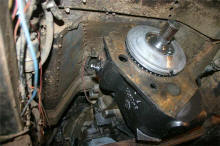
NP 203 Range Box.
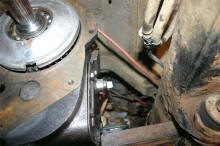
NP 203 cover with fill plug already installed prior to arrival.
3: Ford NP 205 transfer
case. I bought one in a local wrecking yard for $100 and ordered a seal
kit for it from JBG at the same time. When I was digging through the cases
to find the one I wanted I just happened to run across a Ford NP 203 that
I could have bought for $100 if I hadn't ordered the one from Stazworks
already. When I asked why they said they didn't have one the day before
they said it wasn't listed on their inventory.

NP 205 Transfer Case.
4: 203 to 205
Adapter kit (adapter and shaft). This I bought through Stazworks however
it is actually built by Jed's Machining. Cost is the same through either
one which was $450. Shipping for this and the 203 range box was about $100
however it would have been a lot less without the heavy 203 range box
included. I.E. Save some money and get it locally if you can. Note when I
bought the adapter I was given a choice of having it come in 2 pieces so I
could clock the NP 205 up where I wanted it before welding it together
which is the option I chose.
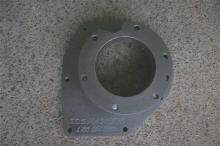
NP 203 to NP 205 Adapter from Jed's Machining.
5: Steel and hardware to
build a triple stick. (One for the 203 and two for the 205 so I could twin
stick it) I chose to hold off on this until I could mock it up in the
garage. I did order a twin stick shifter boot from JBG though.
6: Steel for a new cross
member. I also chose to hold off on this to see what it would require.
This left a couple of items
to consider still. First is that the driveline lengths would change,
second is that the exhaust would need to be changed. I did a bit of
preliminary measuring and it looked like I may get by with simply swapping
the front and rear driveline's. On the exhaust it was a good excuse to put
headers on. I went to EBay and grabbed a set of stock Mustang Shorty
headers off a 95 Mustang. They are stainless steel to keep them from
rusting out and at about $45 including shipping the price couldn't be
beat.
I ordered and obtained the
first 4 items around thanksgiving and they all arrived and sat on the
floor until late in January. I was putting off doing anything with them
due to the weather because I would need to do the work on it outside. (My
Bronco will not fit through my garage door) At that point I was left no
choice though when I was in the middle a big mud hole and the C4 finally
gave out.
Now that I had all of the
major parts and a really compelling reason to go out in the cold I began
by pulling the C4 and Dana 20 out of my Bronco. I pulled them out as a
single unit and put them on the floor of the garage. While I was under
there I cut the complete exhaust out in 4 pieces and put it in the garage
as well with hopes of using it after the conversion. I also pulled the
auxiliary fuel tank out because I had decided to install a larger tank in
back and run a single tank instead.
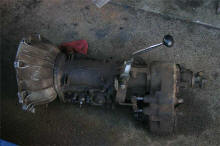
The old C4 and Dana 20 from my Bronco.
Next I assembled the parts
in the garage on the floor next to the old C4 setup. This gave me a good
idea of the length I would be dealing with and enabled me to look at where
I would locate the shifters. I chose to locate them on a single bolt in
one of the bosses that were already in the C6 4WD adapter. I chose the
front one which looked like it matched up pretty close to the original
shifter location on the C4/D20 setup.
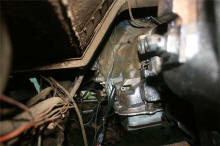
The two C6 adapter bolt bosses can be seen in the upper right area of this
photo.
The bolt
itself I chose to lock into place with a jam nut which would allow me to
adjust how tight the shifter would be mounted. For the shifters I chose to
use a small chunk of heavy bar (About 3/4" x 1 1/4") which I cut into 3
pieces that are each about 1 1/4" long. This created 3 blocks that were
approx. square on one side and were about 3/4" thick. I then drilled holes
in the center of each of them to fit the bolt going into the transmission boss.
If I recall right the bolt is 9/16" by approx. 3 1/2" or 4" long. Then I
drilled and tapped a 1/2 course thread hole in the end of each of them to
fit 3 pieces of 1/2 rod with the ends threaded to fit. I started with
about 18" long on each rod which I would then cut off to the desired
length once I had everything installed in my Bronco. On the opposite end
of each of the blocks I then welded 3 pieces of metal bar that were about
1/4" x 1 1/4" by approx. 3". This gave me the basic shifter assembly that
would pass through the floorboard. I then got to work on the NP 205
transfer case. I first made the shifter modifications that would be
required to make the NP 205 a twin stick. This required removing one of
the shafts and grinding 2 small areas on it to allow the shifters to work
independently without allowing it to be shifted into high and low range at
the same time.
 
NP 205 Twin Stick shifter shaft mods.
Next I had to
decide how to make the inside shifter work on the NP 205 since it sits
behind the adapter and can't be shifted directly with a shift rod. I
settled on a bell crank setup with a bracket and arm that would reach back
behind the adapter and allow the shift rod to connect next to the outer
one. While I was at it I added a small plate to the outer shifter to
connect the rod ends I settled on for linkage between the shifters and the
shifter shafts.

NP 205 shifter bracket and bell crank.
At this point
I had mocked up the shifter linkage and added the 5/16" rod I chose for
linkage between the shifters and the transfer cases with the ends threaded
for 5/16" rod ends.
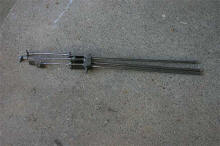 
Basic triple stick shifter assembly prior to final trimming and knob
installation.
After working
out the details of the triple stick shifters I removed all of the gears
from the NP 205 transfer case both to inspect them and to remove a lot of
weight from it so I could handle it easier underneath while I figured out
where I would clock it up so I could weld the adapter together. I then
bolted in the C6 transmission followed by the NP 203 range box. Neither of
these would need to be removed once they were installed so I cleaned them
up and added transmission fluid to the torque converter before I installed them.
I used Blue RTV to seal the surfaces between the C6 and the NP 203. Once
in position I ran a bar underneath them across my radius arms to hold them
up until I could build the cross member.
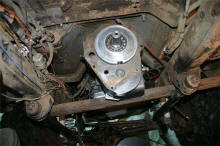
C6 and NP 203 installed and held in place prior to installing the cross
member.
Next I put the
203 to 205 adapter plate on and bolted it to the back of the NP 203 and
did the same with the NP 205 side as well. I then put the NP 205 up there
and made adjustments to it until I was happy with how it fit. The adapter
pieces slide together enough to support the empty NP 205 case which I was
careful to keep up against the NP 203. (Even with it empty it would hurt
if it fell on you) My final position was with the NP 205 clocked up into
position with the bottom of it slightly higher than the bottom of the NP
203. This put the left side fairly flat against the left frame rail. With
a little persuasion I moved the back over slightly to get about a 1/4" gap
between the NP 205 and the left frame rail. When you do this look at the
front driveline position (Don't forget the transmission and transfer case
linkage that also needs to go through there) and check the clearance at
the front of the motor so the fan doesn't end up in the radiator. It may
be worth noting at this point that I do have a 3" body lift. Without it I
think the floorboard would need some changes. The idea of putting it up
high was to get as much clearance underneath as possible and allow me to
later install a skid plate. (More on this later) Once I was happy with the
position I marked the adapter so I could remove it and then weld the two
pieces together. The instructions suggested using a shop press to apply
150 lbs. or so of pressure when welding the 2 together. I substituted a
heavy NP 205 transfer case instead which I set on top of it when I made
the initial tack welds around it.
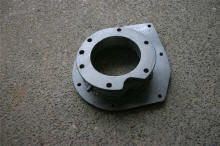
NP 203 to NP 205 adapter after welding and painting.
Following the
welding I assembled the NP 205 transfer case using the new seal kit. A tip
when putting the needle bearings in is to use engine assembly grease to
keep them in place while your putting it together. I then painted the
transfer case prior to installing it.

NP 205 transfer case ready for final installation.
I then bolted
the Adapter and the NP 205 transfer case in. I again used Blue RTV to seal
the surfaces and discarded the gasket that came with the NP 205 seal kit.
For this application the RTV works better than the gasket.
With all of
the pieces now underneath my next task was to fabricate the cross member.
My initial cross member basically consisted of two 1 1/2" x 1/4" bars
running under the frame with a piece of angle on each end. In the front I
used the original C6 transmission mount which already had a rubber bushing and
in back I dug up some shock bushings as a temporary setup until I could
pick up some better bushings. This is the one item I went back and later
changed since I wasn't happy with how it worked out. (More on this later)
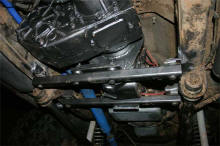
Original Cross Member.
With
everything bolted in now I went to work on the shifters for both the
transfer cases and the transmission. The transfer case shifters bolted
right in with a a few bends in them to position them through the original
hole in the floorboard which I trimmed to be about 2 inches wider. I then
cut the extra length of 1/2" rod off to a height that would allow me to
shift them without breaking my knuckles on the dash. I then threaded each
one with 1/2" threads to fit some plain black knobs. Wild Horses sells
shifter knobs with the patterns on them except that the crawler knob they
sell has the pattern backwards for this setup. I use mine enough that I
have the patterns memorized so I haven't worried about getting knobs with
shift patterns on them.
My next task
was to install the shifter for the transmission. My previous C4 had a
Hurst shifter for it which I always hated because of the way the reverse
lockout worked. I decided to go shopping and picked up a B&M Truck
Megashifter. It sits higher and fits nicely next to the drivers seat.
Between 1st and Drive it works as a ratchet shifter which is nice for
manually shifting while climbing dunes for instance and the reverse
lockout all works from the T handle using one hand. I.E. I can pull the
lockout up and shift back and forth between drive and reverse without
using 2 hands. It has a light for the positions at night and includes
micro switches for the neutral safety switch and the backup lights. (One
of these days I'll wire the switches in) During the installation I ran
into a problem though. The Shifter bracket that connect the cable to the
transmission stuck out too far and was sure to get hit by the front
driveline. To fix this I modified the bracket so it sits in a higher
position that doesn't stick out as far.

Modified transmission shifter cable bracket.

Transmission Shifter and Triple stick shifters installed.
I then placed
the drivelines up under it with the original front and rear ones swapped.
The rear driveline fit the front just right. The back one was compressed
further than hat I was happy with so I modified the spring perches and
u-bolt plates to reposition the axle back about 1 1/2". I've since gone
back and put the springs back in the center of the perches and the u-bolt
plates and instead moved the spring hangers back about 3".
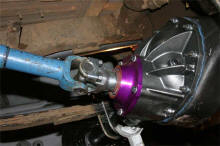 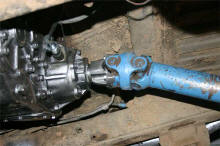
 
Drivelines installed.
Last I wrapped
up the small details like installing the transmission lines (Both the vacuum
line and the cooler lines) and installing a dipstick for it. (I chose a
Lokar flexible one to avoid fighting to make one fit, it helped that Ford
wanted my right arm for a stock dipstick and my right leg for a stock
dipstick tube to fit the original C6) I also picked up a stock kick down
cable to fit the transmission when I bought it so I installed it. Being an 89
transmission the kick down was already set up to work with the bracket on my EFI
so there were no modifications required there.

C6/203/205 Final installation.
At this point
I think I've covered everything on the initial install except for the
exhaust. After looking it over I considered 2 options. First was to run
the drivers side underneath the transmission and then join it with the
passenger side to run a single exhaust out the rear. The second was to run
it over the frame and down the sides instead. I installed the Mustang
headers I had previously obtained and headed to the local hot rod exhaust
specialist. After looking it over we decided the second option would work
the best. I'm very happy with what they put together. I had them install a
new set of Magna Flows as well.
  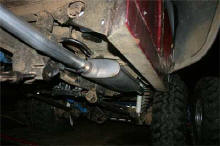
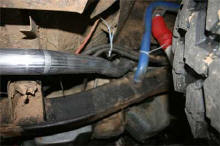  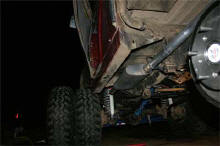
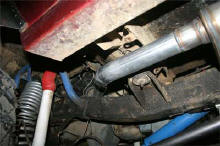
Exhaust installed.
While I was
very happy with how well this setup had worked I later went back and built
the cross member over again. This time I added more support between both
bars and changed to bushings at the frame mounts. The bushings are
actually spring eye bushings which fit 1 1/2" x 0.120 Dom perfectly. I
made it flat at the bottom to make it easy to install a skid plate if I
ever decide to. I've decided not to though right now since the cross
member itself does a pretty good job of protecting the transfer cases
which are already plenty strong anyway. I'm confident that I can slide
over pretty much any rock without breaking the cases the way it is.

New cross member to replace the original one.
Here is a
short video showing the C6/203/205 doubler in action.

Tech article by Rick Halle (SaddleUp)
|



